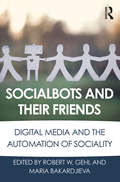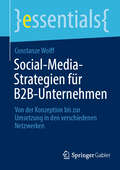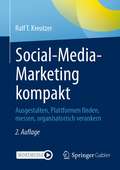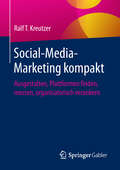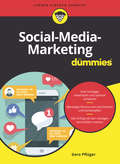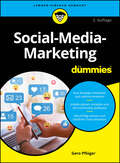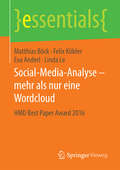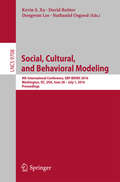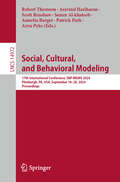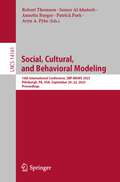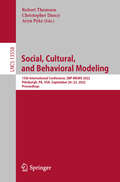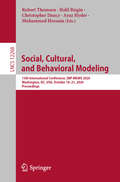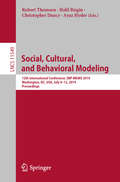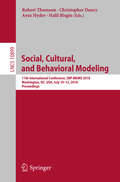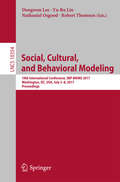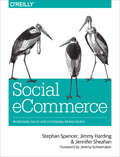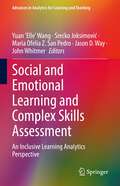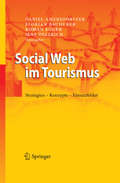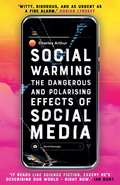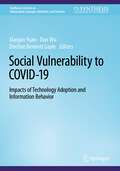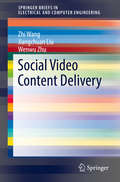- Table View
- List View
Socialbots and Their Friends: Digital Media and the Automation of Sociality
by Robert W. Gehl Maria BakardjievaMany users of the Internet are aware of bots: automated programs that work behind the scenes to come up with search suggestions, check the weather, filter emails, or clean up Wikipedia entries. More recently, a new software robot has been making its presence felt in social media sites such as Facebook and Twitter – the socialbot. However, unlike other bots, socialbots are built to appear human. While a weatherbot will tell you if it's sunny and a spambot will incessantly peddle Viagra, socialbots will ask you questions, have conversations, like your posts, retweet you, and become your friend. All the while, if they're well-programmed, you won't know that you're tweeting and friending with a robot. Who benefits from the use of software robots? Who loses? Does a bot deserve rights? Who pulls the strings of these bots? Who has the right to know what about them? What does it mean to be intelligent? What does it mean to be a friend? Socialbots and Their Friends: Digital Media and the Automation of Sociality is one of the first academic collections to critically consider the socialbot and tackle these pressing questions.
Social-Media-Strategien für B2B-Unternehmen: Von der Konzeption bis zur Umsetzung in den verschiedenen Netzwerken (essentials)
by Constanze WolffStark praxisorientiert und mit konkreten Beispielen zeigt dieses Buch auf, wie B2B-Unternehmen von sozialen Netzwerken profitieren können. Die Lesenden erfahren das Wichtigste über die Social-Media-Landschaft in Deutschland und lernen, wie sie eine individuelle Social-Media-Strategie aufsetzen und diese in den verschiedenen Netzwerken umsetzen. Denn die Suche nach neuen Lieferant*innen, Mitarbeitenden und Kund*innen spielt sich auf Social Media ab – und auch im Service, bei der Verbreitung von Fachinformationen und der Generierung von Website-Traffic geht kein Weg mehr an LinkedIn, Instagram, X und Co. vorbei.
Social-Media-Marketing kompakt: Ausgestalten, Plattformen finden, messen, organisatorisch verankern
by Ralf T. KreutzerDieses Buch verdeutlicht, dass Social-Media-Marketing heute zu einem integralen Bestandteil der Online-Kommunikation geworden ist. Doch welche Ziele lassen sich damit erreichen? Welche Plattformen bieten welche Möglichkeiten? Wie kann der Erfolg einer Social-Media-Kampagne gemessen werden? Von welchen Plattformen sollte man die Finger lassen? Welche Erfolgsfaktoren zählen? Welche Social-Media-KPIs sind relevant? Ist Social-Media-Marketing gut für meine Suchmaschinen-Optimierung? In diesem Werk werden alle zentralen Fragen zum Social-Media-Marketing kompetent beantwortet.In der 2. Auflage wurden alle Kapitel umfassend überarbeitet und zahlreiche neue Entwicklungen integriert. Darüber hinaus wurden Kapitel zum Influencer-Marketing und zu TikTok ergänzt.Der InhaltSocial Media und Social-Media-MarketingZiele und Konzeption des Social-Media-MarketingsInfluencer-MarketingPlattformen für den Einsatz des Social-Media-MarketingsAusgestaltung des Social-Media-MarketingsControlling des Social-Media-MarketingsOrganisatorische Verankerung des Social-Media-Marketings
Social-Media-Marketing kompakt
by Ralf T. KreutzerDieses Buch verdeutlicht, dass Social-Media-Marketing heute zu einem integralen Bestandteil der Online-Kommunikation geworden ist. Doch welche Ziele lassen sich damit erreichen? Welche Plattformen bieten welche Möglichkeiten? Wie kann der Erfolg einer Social-Media-Kampagne gemessen werden? Von welchen Plattformen sollte man die Finger lassen? Welche Erfolgsfaktoren zählen? Welche Social-Media-KPIs sind relevant? Ist Social-Media-Marketing gut für meine Suchmaschinen-Optimierung? In diesem Werk werden alle zentralen Fragen zum Social-Media-Marketing kompetent beantwortet.
Social-Media-Marketing für Dummies (Für Dummies)
by Gero PflügerKein Zweifel: Über soziale Medien erreichen Sie Ihre Kunden am besten, am authentischsten, am persönlichsten. Was kann Ihnen Besseres passieren, als wenn jemand Ihr Produkt beispielsweise auf Facebook mit einer persönlichen Empfehlung versieht? Allerdings ist die Komplexität von Social-Media-Marketing hoch und die Gefahr extrem groß, jede Menge Zeit und Geld in den sozialen Medien zu verpulvern. Dieses Buch senkt die Hürde für den Einsteiger ins Social-Media-Marketing und gibt Ihnen einen einfachen Leitfaden an die Hand, um erfolgreicher im Social Web zu werben. Finden Sie Ihren Wunschkunden, definieren Sie Ihre Ziele und Ihre Marketingstrategie passend zu Ihren Ressourcen und optimieren Sie Ihren Arbeitseinsatz. Werden Sie Ihr eigener Influencer!
Social-Media-Marketing für Dummies (Für Dummies)
by Gero PflügerMit Social Media in die Herzen Ihrer Kunden Kein Zweifel: Über soziale Medien erreichen Sie Ihre Kunden authentisch und persönlich. Allerdings ist die Komplexität von Social-Media-Marketing hoch und die Gefahr groß, Zeit und Geld zu verpulvern. Dieses Buch gibt Ihnen einen einfachen Leitfaden an die Hand, mit dem Sie erfolgreich im Social Web werden. Profitieren Sie von der Erfahrung des Autors: Gero Pflüger zeigt Ihnen, wie Sie Ihren Wunschkunden finden, Ihre Ziele definieren, eine Marketingstrategie passend zu Ihren Ressourcen planen, Ihren Erfolg messen und Ihren Arbeitseinsatz optimieren. Sie erfahren Wie Sie eine Social-Media-Strategie entwickeln Wie Sie die richtigen Plattformen auswählen Warum Sie keine Follower und Interaktionen kaufen sollten Wie Sie richtig auf Social-Media-Krisen reagieren
Social-Media-Kommunikation entlang der Customer Journey: Die Kommunikation durch den Einsatz einfacher, zielgenauer Kennzahlen erfolgsorientiert ausrichten (essentials)
by Gregor HopfDie Unternehmenskommunikation in den sozialen Medien kann durch den Einsatz einfacher, aber zielgenauer Kennzahlen ausgerichtet und entlang der Customer Journey erfolgsorientiert gesteuert werden. Grundlage ist ein Customer Journey Mapping, das alle Berührungspunkte der Kunden entlang ihrer Entscheidungsprozesse mit dem Unternehmen und den Wettbewerbern bestimmt und den einzelnen Phasen und Aufgaben der Customer Journey zuordnet. Durch das Verständnis der verschiedenen Kennzahlen und ihrer Einsatzmöglichkeiten für die Steuerung der einzelnen Aufgaben entlang der Customer Journey können die zu den Zielen des Unternehmens passendsten ausgewählt werden. Dieser essentials-Band stellt die wichtigsten Kennzahlen vor und erklärt, wie aus den einzelnen Kennzahlen ein ganzheitliches Steuerungskonzept entstehen kann - umsetzbar, konkret und zum Unternehmen passend.
Social-Media-Analyse – mehr als nur eine Wordcloud: HMD Best Paper Award 2016 (essentials)
by Matthias Böck Felix Köbler Eva Anderl Linda LeDie Autoren legen beispielhafte Analysemethoden von Social-Media-Daten dar: deskriptive und Data-Mining-Methoden. Mit deren Hilfe werden kundenorientierte Gesch#65533;ftsma#65533;nahmen eingeleitet und ein stetiges Abw#65533;gen zwischen vollautomatisierten und manuellen, kostenintensiven Reports gesteuert. Das Werk liefert eine #65533;bersicht zu aktuell diskutierten Themen wie begleitende Emotionen, Vernetzung der interagierenden User oder Verbindung von Themen. Als Gewinn f#65533;r ein Unternehmen m#65533;ssen die Analysen durch eine strategische Prozedur geleitet werden, um Erkenntnisse in konkrete Handlungsempfehlungen zu #65533;berf#65533;hren. Neben den Potenzialen durch die Anwendung komplexerer Analysemethoden gibt es auch konzeptionelle, technische und ethische Herausforderungen, wie die Autoren veranschaulichen.
Social, Cultural, and Behavioral Modeling: 9th International Conference, SBP-BRiMS 2016, Washington, DC, USA, June 28 - July 1, 2016, Proceedings (Lecture Notes in Computer Science #9708)
by Kevin S. Xu, David Reitter, Dongwon Lee and Nathaniel OsgoodThis book constitutes the refereed proceedings of the 9th International Conference on Social, Cultural, and Behavioral Modeling & Prediction and Behavior Representation in Modeling and Simulation, SBP-BRiMS 2016, held in Washington, DC, USA, in June/July 2016. The 38 full papers presented were carefully reviewed and selected from 78 submissions. The goal of this conference was to build a new community of social cyber scholars by bringing together and fostering interaction between members of the scientific, corporate, government and military communities interested in understanding, forecasting and impacting human socio-cultural behavior. For this three challenges have to be met: deep understanding, socio-cognitive reasoning, and re-usable computational technology. Thus papers come from a wide number of disciplines: computer science, psychology, sociology, communication science, public health, bioinformatics, political science, and organizational science.
Social, Cultural, and Behavioral Modeling: 17th International Conference, SBP-BRiMS 2024, Pittsburgh, PA, USA, September 18–20, 2024, Proceedings (Lecture Notes in Computer Science #14972)
by Robert Thomson Scott Renshaw Aryn Pyke Samer Al-Khateeb Annetta Burger Patrick Park Aravind HariharanThis book constitutes the proceedings of the 17th International Conference on Social, Cultural, and Behavioral Modeling, SBP-BRiMS 2024, which was held in Pittsburgh, PA, USA, during September 18–20, 2024. The 24 full papers presented in this volume were carefully reviewed and selected from 54 submissions. They are grouped into the following topics: advancements in tools and theory; data-driven approaches.
Social, Cultural, and Behavioral Modeling: 16th International Conference, SBP-BRiMS 2023, Pittsburgh, PA, USA, September 20–22, 2023, Proceedings (Lecture Notes in Computer Science #14161)
by Robert Thomson Samer Al-Khateeb Annetta Burger Patrick Park Aryn A. PykeThis book constitutes the proceedings of the 16th International Conference on Social, Cultural, and Behavioral Modeling, SBP-BRiMS 2023, which was held in Pittsburgh, PA, USA in September 2023.The 31 full papers presented in this volume were carefully reviewed and selected from 73 submissions. The papers were organized in topical sections as follows: Detecting malign influence; human behavior modeling; and social-cyber behavior modeling.
Social, Cultural, and Behavioral Modeling: 15th International Conference, SBP-BRiMS 2022, Pittsburgh, PA, USA, September 20–23, 2022, Proceedings (Lecture Notes in Computer Science #13558)
by Robert Thomson Christopher Dancy Aryn PykeThis book constitutes the proceedings of the 15th International Conference on Social, Cultural, and Behavioral Modeling, SBP-BRiMS 2022, which was in Pittsburgh, PA, USA in September 2022.The 25 full papers presented in this volume were carefully reviewed and selected from 50 submissions. The papers were organized in topical sections as follows: computer science, psychology, sociology, communication science, public health, bioinformatics, political science, and organizational science. Numerous types of computational methods are used include, but not limited to, machine learning, language technology, social network analysis and visualization, agent-based simulation, and statistics.
Social, Cultural, and Behavioral Modeling: 14th International Conference, SBP-BRiMS 2021, Virtual Event, July 6–9, 2021, Proceedings (Lecture Notes in Computer Science #12720)
by Robert Thomson Christopher Dancy Muhammad Nihal Hussain Aryn PykeThis book constitutes the proceedings of the 14th International Conference on Social, Cultural, and Behavioral Modeling, SBP-BRiMS 2021, which was held online during July 6–9, 2021.The 32 full papers presented in this volume were carefully reviewed and selected from 56 submissions. The papers were organized in topical sections as follows: COVID-related focus; methodologies; social cybersecurity and social networks; and human and agent modeling. They represent a wide number of disciplines including computer science, psychology, sociology, communication science, public health, bioinformatics, political science, and organizational science. Numerous types of computational methods are used including, but not limited to, machine learning, language technology, social network analysis and visualization, agent-based simulation, and statistics.
Social, Cultural, and Behavioral Modeling: 13th International Conference, SBP-BRiMS 2020, Washington, DC, USA, October 18–21, 2020, Proceedings (Lecture Notes in Computer Science #12268)
by Robert Thomson Christopher Dancy Ayaz Hyder Halil Bisgin Muhammad HussainThis book constitutes the proceedings of the 13th International Conference on Social, Cultural, and Behavioral Modeling, SBP-BRiMS 2020, which was planned to take place in Washington, DC, USA. Due to the COVID-19 pandemic the conference was held online during October 18–21, 2020. The 33 full papers presented in this volume were carefully reviewed and selected from 66 submissions. A wide number of disciplines are represented including computer science, psychology, sociology, communication science, public health, bioinformatics, political science, and organizational science. Numerous types of computational methods are used, such as machine learning, language technology, social network analysis and visualization, agent-based simulation, and statistics.
Social, Cultural, and Behavioral Modeling: 12th International Conference, SBP-BRiMS 2019, Washington, DC, USA, July 9–12, 2019, Proceedings (Lecture Notes in Computer Science #11549)
by Robert Thomson Christopher Dancy Ayaz Hyder Halil BisginThis book constitutes the proceedings of the 12th International Conference on Social, Cultural, and Behavioral Modeling, SBP-BRiMS 2019, held in Washington, DC, USA, in July 2019. The total of 28 papers presented in this volume was carefully reviewed and selected from 72 submissions. The papers in this volume show, people, theories, methods and data from a wide number of disciplines including computer science, psychology, sociology, communication science, public health, bioinformatics, political science, and organizational science. Numerous types of computational methods are used include, but not limited to, machine learning, language technology, social network analysis and visualization, agent-based simulation, and statistics.
Social, Cultural, and Behavioral Modeling: 11th International Conference, SBP-BRiMS 2018, Washington, DC, USA, July 10-13, 2018, Proceedings (Lecture Notes in Computer Science #10899)
by Robert Thomson Christopher Dancy Ayaz Hyder Halil BisginThis book constitutes the proceedings of the 11th International Conference on Social, Cultural, and Behavioral Modeling, SBP-BRiMS 2018, held in Washington, DC, USA, in July 2018. The total of 27 short and 18 full papers presented in this volume was carefully reviewed and selected from 85 submissions. The contributions were organized in topical sections named: advances in sociocultural and behavioral process modeling; information, systems, and network science; applications for health and well-being; military and intelligence applications; cybersecurity.
Social, Cultural, and Behavioral Modeling: 10th International Conference, SBP-BRiMS 2017, Washington, DC, USA, July 5-8, 2017, Proceedings (Lecture Notes in Computer Science #10354)
by Dongwon Lee, Yu-Ru Lin, Nathaniel Osgood and Robert ThomsonThis book constitutes the refereed proceedings of the 10th International Conference on Social, Cultural, and Behavioral Modeling & Prediction and Behavior Representation in Modeling and Simulation, SBP-BRiMS 2017, held in Washington, DC, USA, in July 2017.The 16 full papers and 27 short papers presented were carefully reviewed and selected from 79 submissions. Owing to its strong multi-disciplinary heritage, the papers represent a large range of disciplines including computer science, psychology, sociology, communication science, public health, bioinformatics, political science, and organizational science and use numerous types of computational methods such as machine learning, language technology, social network analysis and visualization, agent-based simulation, and statistics. They are organized in the following topical sections: behavioral and social sciences; cyber and intelligence applications; information, systems, and network sciences; and methodology.
Social eCommerce: Increasing Sales and Extending Brand Reach
by Stephan Spencer Jennifer Sheahan Jimmy HardingWant to make money online? Then ignore social media at your own risk. Social media is vital if you want to your business to thrive, and though you can’t control the conversations, you can influence them. This book will teach you how.If mismanaged, social media can create more noise than signal. It can be a time and energy suck—for you and your audience. Or worse still, it can become an echo chamber for negative PR.If done well, guerrilla social media marketing can help you persuade, command attention, establish dialogue, differentiate yourself, capture new markets, and outmaneuver the competition—all on a shoestring budget. Whether you’re selling digital goods and services, physical goods, or local services, this book has the answers.Strategize and optimize your social presence in ways you didn’t know were possibleDrive more clicks and sales with better-performing Facebook adsDevelop remarkable content with viral potentialManage your online reputation, instead of letting it manage youIntegrate social media into your SEO strategy, and vice versaLeverage online influencers to promote your brand, and become an influencer yourself
Social eCommerce
by Stephan Spencer Jennifer Sheahan Jimmy HardingWant to make money online? Then ignore social media at your own risk. Social media is vital if you want to your business to thrive, and though you can't control the conversations, you can influence them. This book will teach you how.If mismanaged, social media can create more noise than signal. It can be a time and energy suck--for you and your audience. Or worse still, it can become an echo chamber for negative PR.If done well, guerrilla social media marketing can help you persuade, command attention, establish dialogue, differentiate yourself, capture new markets, and outmaneuver the competition--all on a shoestring budget. Whether you're selling digital goods and services, physical goods, or local services, this book has the answers.Strategize and optimize your social presence in ways you didn't know were possibleDrive more clicks and sales with better-performing Facebook adsDevelop remarkable content with viral potentialManage your online reputation, instead of letting it manage youIntegrate social media into your SEO strategy, and vice versaLeverage online influencers to promote your brand, and become an influencer yourself
Social and Ethical Considerations of AI in East Asia and Beyond (Philosophy of Engineering and Technology #47)
by Benedict S. B. Chan Levi CheckettsThis book is a global reflection on disparate religious and philosophical approaches to questions of AI and the particular ways these questions affect East Asian societies. These chapters originate from a conference held at Hong Kong Baptist University in April 2023 on “Ethical and Social Issues in AI: East Asia and Beyond.” Sections cover Confucianist, Daoist, and Christian reflections on AI ethics. Chapters on broad theoretical questions that AI poses are included as well as those addressing issues in applied AI ethics. This volume appeals to students and researchers working across cultures and traditions on the philosophy of AI technology.
Social and Emotional Learning and Complex Skills Assessment: An Inclusive Learning Analytics Perspective (Advances in Analytics for Learning and Teaching)
by Yuan ‘Elle’ Wang Srećko Joksimović Maria Ofelia Z. San Pedro Jason D. Way John WhitmerIn this book, we primarily focus on studies that provide objective, unobtrusive, and innovative measures (e.g., indirect measures, content analysis, or analysis of trace data) of SEL skills (e.g., collaboration, creativity, persistence), relying primarily on learning analytics methods and approaches that would potentially allow for expanding the assessment of SEL skills and competencies at scale. What makes the position of learning analytics pivotal in this endeavor to redefine measurement of SEL skills are constant changes and advancements in learning environments and the quality and quantity of data collected about learners and the process of learning. Contemporary learning environments that utilize virtual and augmented reality to enhance learning opportunities accommodate for designing tasks and activities that allow learners to elicit behaviors (either in face-to-face or online context) not being captured in traditional educational settings. Novel insights provided in the book span across diverse types of learning contexts and learner populations. Specifically, the book addresses relevant and emerging theories and frameworks (in various disciplines such as education, psychology, or workforce) that inform assessments of SEL skills and competencies. In so doing, the book maps the landscape of the novel learning analytics methods and approaches, along with their application in the SEL assessment for K-12 learners as well as adult learners. Critical to the notion of the SEL assessment are data sources. In that sense, the book outlines where and how data related to learners' 21st century skills and competencies can be measured and collected. Linking theory to data, the book further discusses tools and methods that are being used to operationalize SEL and link relevant skills and competencies with cognitive assessment. Finally, the book addresses aspects of generalizability and applicability, showing promising approaches for translating research findings into actionable insights that would inform various stakeholders (e.g., learners, instructors, administrators, policy makers).
Social Web im Tourismus
by Roman Egger Florian Bauhuber Jens Oellrich Daniel AmersdorfferZiel der Autoren ist es, Mechanismen und Prinzipien des Social Webs im Tourismus aufzuzeigen. Neben den theoretischen Grundlagen erläutern sie die praktischen Anwendungen und illustrieren das Thema anhand vieler Best-Practice-Beispiele. Leser erfahren, welche Bedeutung das Social Web und seine grundlegenden Mechanismen haben, so dass Internet-Aktivitäten besser geplant und an neue Entwicklungen angepasst werden können. Für Akteure in der Tourismusbranche, aber auch Wissenschaftler, die einen Einstieg in die touristische Praxis des Social Web suchen.
Social Warming: The Dangerous and Polarising Effects of Social Media
by Charles ArthurNobody meant for this to happen. Facebook didn&’t mean to facilitate a genocide. Twitter didn&’t want to be used to harass women. YouTube never planned to radicalise young men. But with billions of users, these platforms need only tweak their algorithms to generate more &‘engagement&’. In so doing, they bring unrest to previously settled communities and erode our relationships. Social warming has happened gradually – as a by-product of our preposterously convenient digital existence. But the gradual deterioration of our attitudes and behaviour on- and offline – this vicious cycle of anger and outrage – is real. And it can be corrected. Here&’s how.
Social Vulnerability to COVID-19: Impacts of Technology Adoption and Information Behavior (Synthesis Lectures on Information Concepts, Retrieval, and Services)
by Dan Wu Xiaojun Yuan DeeDee Bennett GayleThis book provides an overview of the impact of the pandemic in China and the USA and presents a research agenda for use, access, and adoption of information and communication technologies (ICT) in the era of COVID-19. The global COVID-19 pandemic changed lives overnight and exposed socially vulnerable populations to ever-challenging situations. One significant challenge was the use, access, and adoption of technological resources. To understand how socially vulnerable populations managed the COVID-19 pandemic and adapt to the new normal, it is important for researchers and practitioners to identify the challenges and understand the perceptions of technologies. Through various research studies, this edited volume addresses the impact of the global COVID-19 pandemic and the adoption of technologies (from artificial intelligence to telehealth and telecommunications) among some socially vulnerable populations (including children, older adults, COVID-19 patients, and general marginalized populations) in the world. The information divide faced by socially vulnerable groups is studied as well as the dimension of vulnerabilities and the impacts of specific technologies.
Social Video Content Delivery
by Zhi Wang Jiangchuan Liu Wenwu ZhuThis brief presents new architecture and strategies for distribution of social video content. A primary framework for socially-aware video delivery and a thorough overview of the possible approaches is provided. The book identifies the unique characteristics of socially-aware video access and social content propagation, revealing the design and integration of individual modules that are aimed at enhancing user experience in the social network context. The change in video content generation, propagation, and consumption for online social networks, has significantly challenged the traditional video delivery paradigm. Given the massive amount of user-generated content shared in online social networks, users are now engaged as active participants in the social ecosystem rather than as passive receivers of media content. This revolution is being driven further by the deep penetration of 3G/4G wireless networks and smart mobile devices that are seamlessly integrated with online social networking and media-sharing services. Despite increasingly abundant bandwidth and computational resources, the ever-increasing volume of data created by user-generated video content--along with the boundless coverage of socialized sharing--presents unprecedented challenges.
